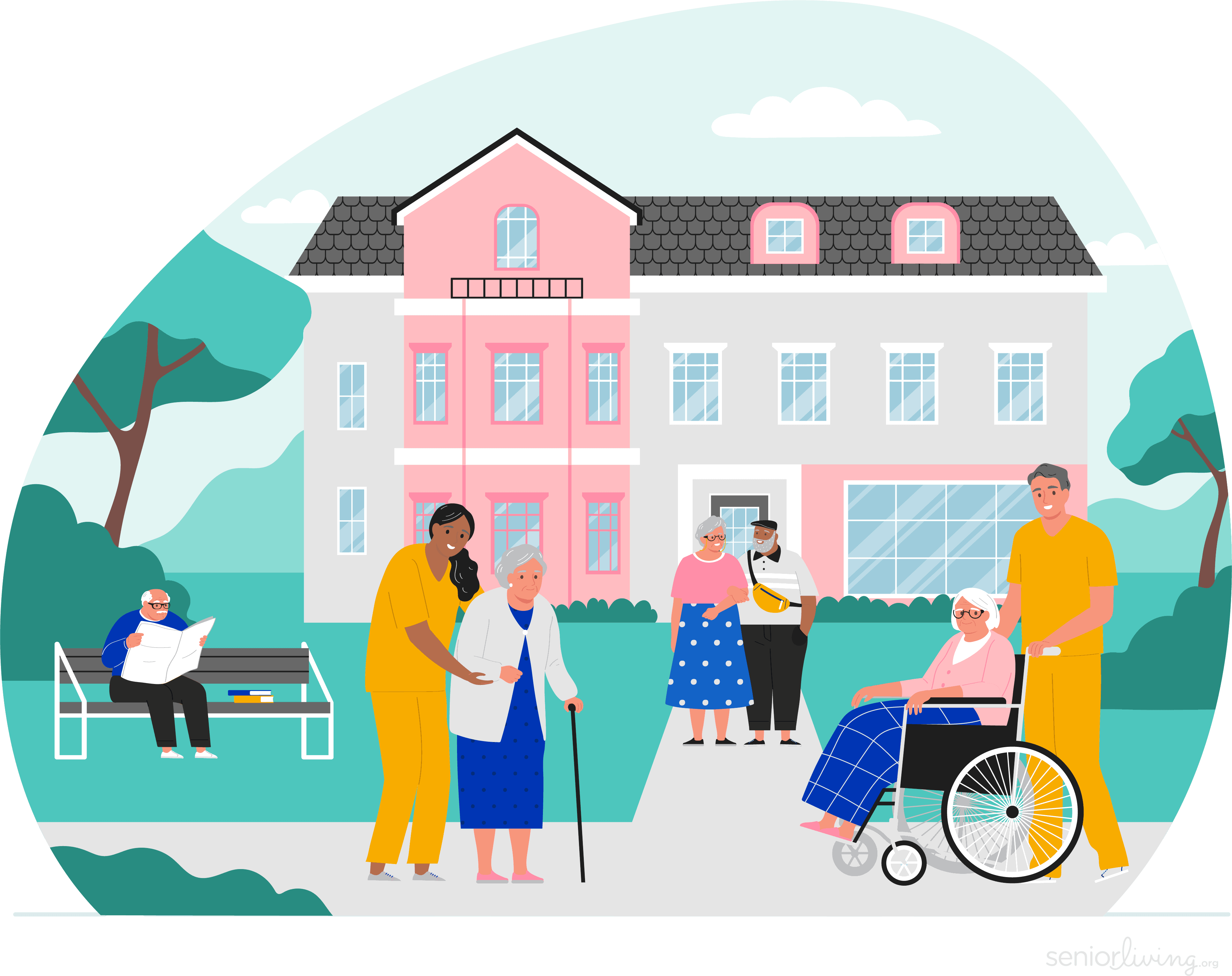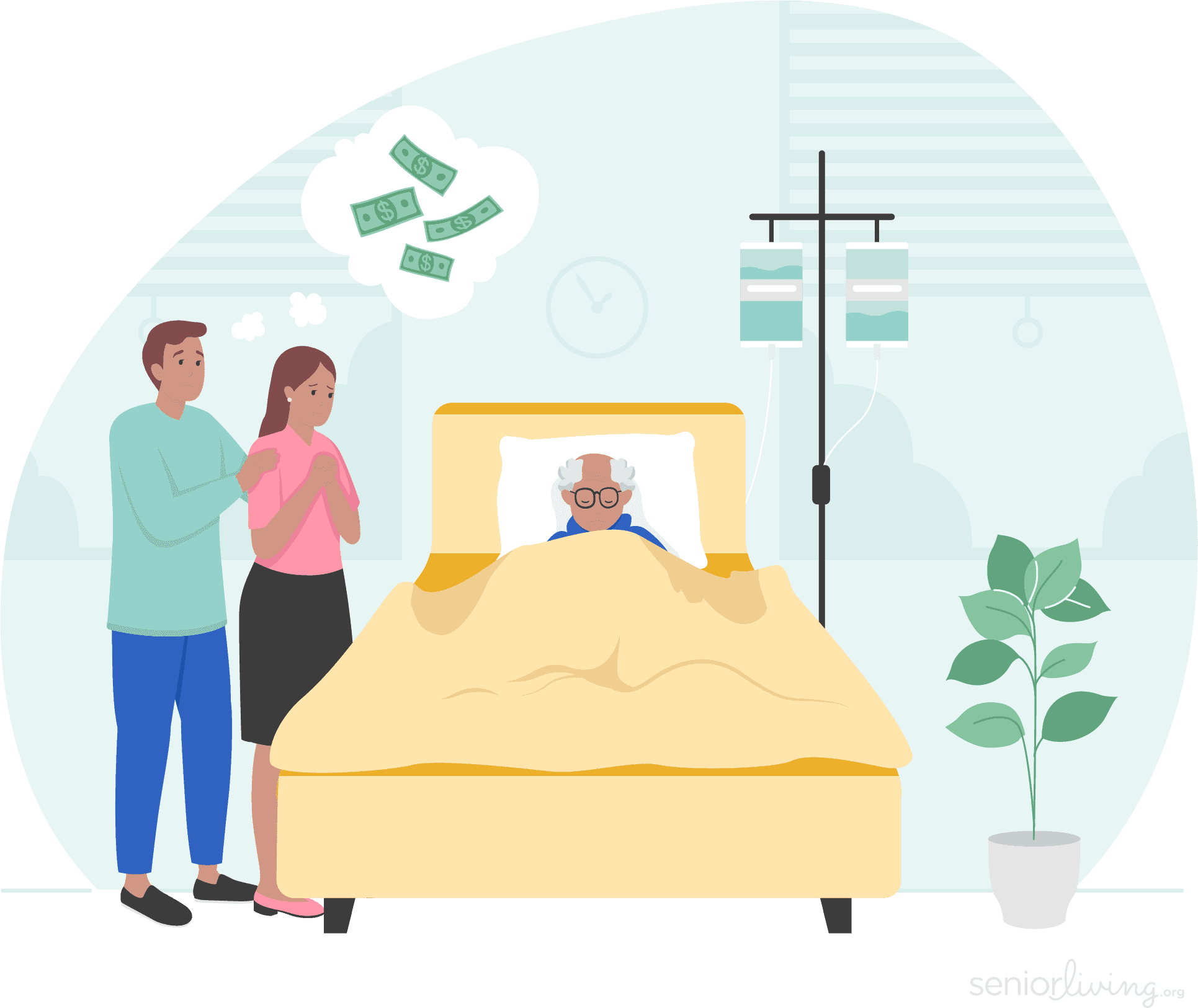Senior Care and Housing Costs
SeniorLiving.org is supported by commissions from providers listed on our site. Read our Editorial Guidelines
Get Quotes for Senior Care Near You
Join 1,019,247 Seniors Who've Searched for Housing Communities on SeniorLiving.org.
Get Quotes for Senior Care Near You
In years past, it was practically unheard of for people to live to be 100. Now, people in the U.S. routinely hit that number.1 Of course, life expectancy varies significantly. But one thing is clear: Many older adults need extra help decades before 100 candles make it onto their birthday cake. For some, this translates into help at home or new housing. It also means figuring out how to pay for senior care.
If you or a loved one is approaching 70, 80, 90 or beyond, you may be assessing your current living situation and considering next steps. If so, concerns about finances may be keeping you up at night.
In this article, we’ll go over the range of senior care housing options, from in-home support to hospice care. We’ll also examine the costs associated with each type of care.
Table of Contents
In-Home Care
In-home care costs vary by category. Your state of residence, the number of hours your aide works, and the agency you choose, will also impact upon cost.
According to Genworth Financial’s Cost of Care Survey, monthly median costs are around $5,625 for a home health aide and $5,417 for homemaker services in 2024.2
In-home care enables many older adults to safely age in place. If you or your loved one needs support with activities of daily living (ADLs), hiring a home health aide or an aide who supplies homemaker services, may give you enough support to stay in your home.
In-home care duties vary but typically include help with ADLs such as bathing, cooking, home maintenance, and medication management.
» Related Reading: Help paying for home care
The tasks you need support with will determine the type of worker you need. To find help, you may decide to find a private home health agency on your own. If you or your loved one needs care after a hospital stay, you may also be assigned to a case management agency that will help you find the right type of care.
Home Health Aides
The requirements to be a home health aide vary by state. Usually, home health workers are unlicensed, but many undergo training and are required to complete a competency evaluation training.3
Home health aides provide help with personal ADLs like bathing, dressing, and appointment planning. They may also shop for groceries and cook meals. In addition to these types of tasks, home health aides also provide basic health services as needed. These often include medication management, checking vital signs, and wound care. They may also help with mobility assists like wheelchairs and artificial limbs.
Medicare covers part-time or intermittent home health services that are considered medically necessary. Usually, this requires a medical diagnosis that indicates you’re homebound, or need mobility and transportation support.4 Medicare won’t cover around-the-clock medical care in your home. They also don’t cover home care if it’s needed solely for personal ADLs, like grooming.
» Learn About: Medicare coverage for home care
Private insurance often provides some level of coverage for home health support. Check with your plan to determine what they will cover and what your out-of-pocket costs will be.
Medicaid coverage varies from state to state but often covers home health and personal care services.5
Did You Know? iors with limited income and resources may be eligible for Medicaid, even if they’re already enrolled in Medicare. If you’re eligible, Medicaid will help pay for out-of-pocket costs not covered by Medicare.6
Homemaker Services
If you or your loved one don’t need health-related support, you may be better served with an aide who provides less expensive homemaker services. Homemaker assistance for older adults can include tasks like laundry, vacuuming, and running errands. Personal care like bathing, shaving, and brushing hair, are not normally folded into homemaker services.
Since they’re not classified as medical needs, homemaker services are not covered by Medicare.4 Medicaid may cover housekeeping services in some instances.8
Assisted Living
Assisted living costs vary between facilities, and prices are based on a wide range of factors. These include location, the types of amenities provided, and whether or not you share a space or have your own apartment. In 2024, the median cost of assisted living in the U.S. is just under $5,000 per month. 2
If you or your loved one needs a higher level of care than you can get at home, an assisted living community may make sense. Here you’ll find support 24/7 with personalized ADLs like bathing and grooming. Assisted living also provides access to health-related care like medication management. Assisted living facilities offer a home-like atmosphere, combined with social activities like scheduled events and communal dining.
» Further Reading: A guide to assisted living communities
If you have a long-term care insurance policy, it may cover all or part of your assisted living expenses. Make sure to check your policy to figure out what they’ll pay for and what you may need to pay out of pocket. 10
Medicare doesn’t cover assisted living costs like rent or ADL support. It does, however, cover medical expenses you incur while residing at the facility. These include doctor’s appointments, skilled nursing care, and emergency medical care.
Medicaid coverage for assisted living varies by state. You may get more financial support for assisted living from Medicaid than from Medicare. However, your choice of facility may be limited.
Nursing Home
Nursing home costs can be considerable. Your state of residence, the facility you choose, and your choice of a private or semiprivate room will all impact costs. Genworth estimates median monthly nursing home costs to be around $8,641 for a semiprivate room and $9,872 for a private room.
Nursing homes are designed to provide a higher level of medical support and care than assisted living facilities can. Life here feels less independent, in most cases. However, skilled nurses and nursing aides are available 24/7, so medical support is never far away.
» Dive Deeper: A 2024 guide to nursing homes
Long-term care insurance policies often cover all or most nursing home expenses.10 Medicare only covers the first 100 days of a nursing home stay. It doesn’t cover long-term stays but will cover the medical expenses you’ll incur while you’re in residence.
Medicaid covers the cost of nursing homes, provided you qualify. In some instances, you’ll need to “pay down” your assets before Medicaid will provide coverage. Not every nursing home accepts Medicaid, so this will be an important question to ask if you have or plan on applying for this coverage.
Memory Care

In a nursing home, memory care costs are typically all-inclusive. NCOA estimates memory care costs in a nursing home to be around $7,908 a month for a semiprivate room and $9,034 a month for a private room.12 Just remember, prices will vary by your location and chosen facility.
Memory care is a specialized type of care for people with dementia and illnesses that cause memory impairment. If your loved one has Alzheimer’s disease, Parkinson’s disease, or other conditions that cause cognitive impairment, they may be best served in a memory care facility.
Did You Know? Most dementia caregivers are female, according to the World Health Organization. Around 70 percent of care hours given to people with dementia are provided by women.13
Memory care facilities are designed for comfort, safety, and ease of use for people with memory issues. Some assisted living facilities have memory care community wings. Many nursing homes have floors or wards dedicated to memory care patients. There are also private facilities that solely offer this level of care.
Memory care facilities have highly trained personnel and facilities geared toward preventing wandering. These added expenses typically make memory care costs higher than those associated with nursing homes or assisted living.
Medicare covers some of the costs associated with dementia, such as cognitive assessments. Medicaid covers memory care in nursing homes, if you qualify.14 Long-term care insurance is another option for paying for memory care.
Adult Day Care
Similar to other forms of care, adult day care costs are impacted by your geographic location and the number of hours you or your loved one will spend there daily. Transportation may also cost extra. According to Genworth, the median cost for adult day care is around $85 per day. Medicare doesn’t cover the cost of adult day care, but Medicaid typically does.
Seniors who live at home may benefit significantly from going to adult day care centers. These centers offer different levels of services. Some are geared primarily toward socialization, exercise, and fun activities. Others offer health, therapeutic, or memory care. The type you choose will determine your costs.
Respite Care
Respite care can be provided within the home or outside of the home in adult day care, or at a facility. Respite care costs vary significantly based on the type of respite care and location you choose.
In the home, you’ll pay the average hourly or daily rate for home health aides. Overnight stays may be more expensive. According to Genworth, the median cost for a home health aide is $29.50 per hour in the U.S. These rates are bound to vary between states and possibly even neighborhoods.
» Take Care of Yourself: Signs you’re experiencing caregiver burnout
Being a caregiver can be exhausting and frustrating. If a primary caregiver is at the end of their rope, everyone suffers. Short-term respite care is designed to provide relief to caregivers who simply need a short-term break. Respite care enables you to “pass the reins” to someone else for several hours a day, or even for weeks at a time.
Hospice Care
Hospice care costs are often covered in part by private insurance plans. You may have copays and a deductible that you’ll be responsible for. Medicaid and Medicare cover 100 percent of the cost of hospice care. If you have Medicare, you may incur copays for prescription
» Learn About: Medicare and Medicaid coverage for hospice care
Hospice care is end-of-life care for people who are expected to live no more than six months. It may be provided within the home or at a facility. Making your loved one feel safe and comfortable is the main goal of hospice care. Pain management and other types of support, such as bereavement counseling for the family, are part of hospice care.
Continuing Care Retirement Communities
CCRCs charge monthly fees and entry fees, which can be staggering. These vary by state and by facility. In New York, entry fees range from $200,000 to $1 million. Monthly fees range from $2,000 to $5,000 per
These costs are not covered by any type of insurance or public assistance program. However, medical fees you incur while in residence are usually covered by insurance plans, including Medicare.
Life plan communities are also referred to as continuing care retirement communities (CCRCs). They’re geared toward highly independent seniors who want a rich menu of living options and services. Often, couples move to CCRCs together, even if they have differing medical needs.
CCRCs are designed to provide care at varying levels, so you can change the type of services you need if your medical needs change. Memory care and skilled nursing care are typically available.
How to Pay for Senior Care
As we mentioned in the sections above, Medicare, Medicaid, and long-term care insurance are common ways you may be able to pay for some types of senior care.
In addition to these options, you may be able to use veterans benefits to pay for medical care and memory care at home and in nursing homes. Housebound veterans may also be eligible for an additional stipend to their monthly pensions that you can put toward uncovered services, like the rent at an assisted living
Many people also use their assets to pay for senior care. You may be able to use your life insurance policy, savings, or a reverse mortgage to pay for care.
No matter how you decide to cover these expenses, planning for housing in retirement in your later years is an essential step to reaching these goals with confidence.
Comparing Your Senior Care Options and Costs
This bubble graph is designed to easily display all of your options for senior housing and their costs. We’ve gone from least expensive to most expensive, so you can zero in on the care option that best serves your budget.
Chobanian & Avedisian School of Medicine. (2023). Centenarian Statistics.
Genworth. (2022). Cost of Care Survey.
New York State Education Department. (2024). Home Health Aide.
Medicare.gov. (2024). Home health services.
Department of Health. (2024). Personal Care Services Program (PCS).
Medicaid.gov. (2024). Seniors & Medicare and Medicaid Enrollees.
NY Health Access. (2022). Medicaid Personal Care or Home Attendant Services.
NCOA. (2023). Does Long-Term Care Insurance Cover Assisted Living? A Comprehensive Guide.
NCOA. (2023). The Cost of Memory Care: What To Expect.
World Health Organization. (2023). Dementia.
HealthCare.gov. (2017). Medicare and Medicaid Benefits for People with Dementia Brochure.
Medicare.gov. (2024). Hospice care.
Department of Financial Services. (2024). About Continuing Care Retirement Communities.
U.S. Department of Veterans Affairs. (2024). Veterans.








